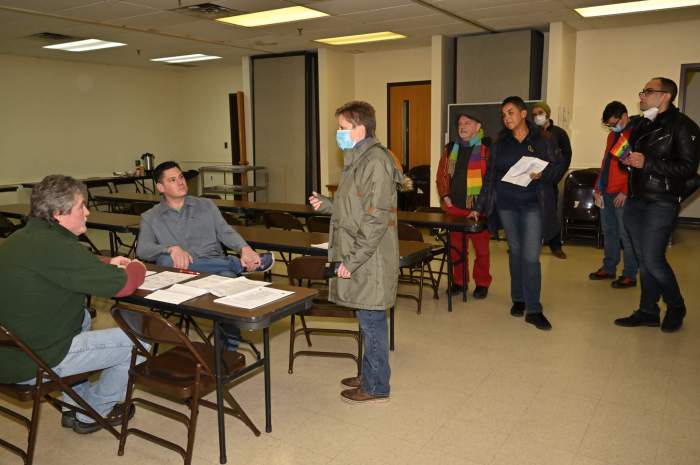By Ann Kjellberg
If the mayor’s proposed budget goes through and the promised 4,000 New York City teachers are laid off (costing the city 6,000 jobs, with attrition), P.S. 41, in the heart of Greenwich Village, will lose 12 teachers. That is more than the number of teachers now teaching the school’s fourth and fifth grades.
According to the city’s statistics, the P.S. 41 building is already “utilized” at 118 percent. City officials consider an appropriate “utilization” rate to be around 85 percent. The reason P.S. 41 is overcrowded by 30 percentage points is largely due to the city’s failure to plan for the last decade’s residential building boom. Education advocates expect that if layoffs go forward, class sizes in New York City, which have been rising for the last three years and are now at their highest in a decade, will jump citywide by a further 13 percent. My daughter began kindergarten at P.S. 41 in what I considered a large class of 22. Now, in fourth grade before layoffs, her class is 30.
Increased class size is not the only threat from Bloomberg’s education budget. In a system that gives substantial autonomy to principals, P.S. 41 will lose a dozen teachers it has spent the last year or so grooming and training in the school’s curriculum and practices. These teachers will have to be retrained elsewhere, and their replacements, if there is money to hire them, will also have to be retrained. Many of these laid-off educators will give up in despair and move to other cities or other professions — a terrible loss in a field starved of qualified manpower.
But the pain doesn’t end there. Since the recession hit in 2008, schools’ individual budgets have already been sliced by more than 12 percent. Department of Education officials refuse to divulge what the school-based budget consequences of the current cuts will be come September, feeding fears that they will be dire.
Many schools will lose teachers beyond compulsory layoffs simply because they can no longer afford to pay them. They will also lose extra help for struggling students and students who are ready for more challenges, and staff for arts and physical education, nursing, guidance, administration and security.
Materials will once again not be replaced: Parents will be begged for markers and Kleenex. The Bloomberg administration’s overwhelming focus on test-score gains will mean that a larger and larger share of schools’ dwindling resources will be aimed at bringing a maximum number of children to minimum proficiency in test-taking.
Parents and teachers have been battling the proposed cuts since they were first announced by Bloomberg in November of last year. Bloomberg blamed the cuts on diminished state aid from Albany. And yet many parents and teachers noted that they did not see Bloomberg, Schools Chancellor Cathie Black or her successor, Dennis Walcott, fighting in Albany for more funds.
Bloomberg appeared more intent on using the threat to challenge the teachers union’s seniority policies, which direct layoffs at the most junior teachers, and to weaken the union in long-overdue contract negotiations.
Bloomberg also did not support an extension of the so-called “millionaires’ tax,” an 8.9 percent tax imposed in 2009 on New Yorkers making more than $500,000 a year, that would easily have closed the city’s education budget gap.
In March the state did pass a budget with $240 million more in education funds than in Governor Cuomo’s proposed budget, upon which Bloomberg’s estimates were based. But the mayor apparently had other uses for the city’s share than applying it toward the $269 million needed to avoid teacher layoffs.
Local parents have risen up, phoned officials, and marched in citywide rallies on May 5 and May 12. On April 15, P.S. 41 kids rallied and sang their own version of the Katy Perry song “Firework” to express solidarity with their teachers and beg for their jobs.
With Bloomberg not budging, Assembly Speaker Silver reintroduced the millionaires’ tax, with the support of Village legislators Deborah Glick and Tom Duane. Even without the tax, many parents and city councilmembers believe that the money to save those jobs can be found in the budget. They propose that D.O.E. curtail the $166 million slated to expand charter schools, which will take up $700 million of the education budget to benefit a small percentage of the student population.
They challenge the $20 million slated for teacher recruitment, an ironic luxury under the circumstances. They challenge the new roster of standardized tests set to roll out next fall before they have been reviewed by teachers or vetted against the new statewide curricular standards.
Critics also propose tapping the $300 million Bloomberg will place in budgetary reserve for 2012, $200 million more than is mandated by law.
Most disturbingly, D.O.E. is dedicating $500 million in capital funds, and untold man hours, to initiatives in new technology and online learning that are mostly unproven or have shown dubious results in classrooms. Former Chancellor Klein once told The New York Times that in his dream future D.O.E. would replace 30 percent of its teaching force with computers.
But most critics point to the apparent epidemic in wasteful D.O.E. contract spending. An audit from Comptroller John Liu’s Office uncovered a $19 million cost overrun in the contract to manage high school admissions.
This on top of the large salaries and constant expansion of D.O.E.’s own staff: Bloomberg proposes to increase the central office’s size this year by 218, at a cost of $10 million.
During budget hearings on June 1, Speaker Quinn’s Office, with the Council’s Finance Committee Chairperson Domenic Recchia, proposed $75 million in alternative cuts toward saving teachers’ jobs. The speaker had hitherto been fairly silent on the subject, issuing two press releases promising to seek alternate cuts but failing to show up at budget hearings or rallies in support of teachers, including the one in her district at P. S. 41. Many observers wondered what such a modest proposal could do in practical terms to end the stalemate, and the Speaker’s Office refused to comment on Quinn’s next step, except to say in a press release that they “will continue to identify and push for other cuts to be made in order to save our teachers.”
Observers hope the speaker’s proposal is an opening foray in a more vigorous defense of the education budget leading up to the Council’s vote later this month, or perhaps part of some negotiated endgame.
Meanwhile, the 40-plus, 5-year-olds on the wait list for spots in the P.S. 41 kindergarten have reportedly been offered places in P.S. 3 and P.S. 11, schools where some new space was created last year by moving middle schools out of the attic (leaving the Village without a middle school).
This is the first time places have not been found within the zone for all zoned children. In spite of the dramatic growth in school-age population in the Village and even substantial (but inadequate) allocation of funds, not a single new seat has been built here since the population boom began. Let’s hope there will at least be teachers there when these kids squeeze into their classrooms in September, and some commitment to the funds needed to shelter and educate them.
Kjellberg is a P.S. 41 parent and a founding member of P.S. PAC, an informal coalition of P.T.A. political advocacy committees working together on common concerns.































